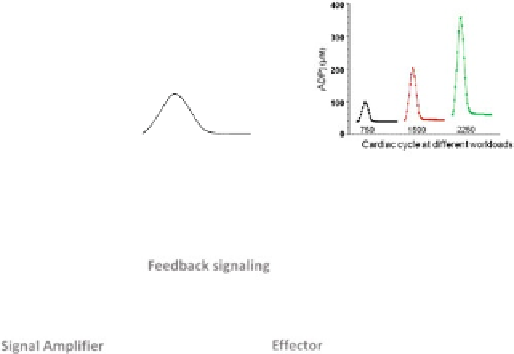Biology Reference
In-Depth Information
a
b
c
10000
0
8000
-500
6000
-1000
4000
-1500
2000
-2000
0
0
0.06
0.12
0.18
0
0.06
0.12
0.18
Time of cardiac cycle (s)
Time of cardiac cycle (s)
d
Informaon transfer
Feedback signaling
[ADP]c, AMPc ; Cr/PCr
Signal Amplifier
ATP synthasome-MtCK-VDAC-βII-tubulin
Effector
PCr flux
Input
Output -
Work
MM CK
-
Substrates
supply, VO
2
Energy transfer
E-C coupling (CRU),
Length dependant
sarcomere acvaon
Fig. 11.10
Mechanisms of regulation of mitochondrial respiration controlled by MtCK and of
energy fluxes in cardiac muscle cells
.(a-c) Results from a mathematical model of cardiac energy
metabolism (Vendelin-Aliev-Saks-Dos Santos model). (a,b) Calculated net PCr production rates
in nonequilibrium steady state MtCK reaction (a) and cyclic changes in rates of ATP regeneration
in nonequilibrium myofibrillar MM-CK reaction (b) during contraction cycles at different
workloads corresponding to oscillations of [ADP]c indicated in Fig.
11.11
.(c) Mathematically
modeled oscillations of ADP concentrations in the core of myofibrils over cardiac cycle at
workloads equivalent
mol ATP s
1
kg
1
.
According to this model, the ATP cyclically produced during contractions (b) is associated with
cyclical oscillations of ADP and Pi concentrations in myofibrils (c) and subsequent PCr production
in the MtCK reaction (a). Reproduced from (Dos Santos et al.
2000
; Aliev et al.
2012
; Aliev and
Saks
1997
; Vendelin et al.
2000
) with permission. (d) Schematic representation of feedback
metabolic signaling in regulation of energy metabolism within ICEUs in cardiac cells. Due to
the nonequilibrium MtCK and cyclic MM-CK reactions, intracellular ATP utilization (output) and
mitochondrial ATP regeneration (input) are linked via cyclic fluctuations of cytosolic ADP and
Cr/PCr. See the text for explanation
to 750 (
black
), 1,500 (
red
) and 2,250 (
green
)
μ
MOM, as in mitochondria in situ, the apparent
K
m
for free ADP increases to about
370.75
M and the respiration rate becomes almost linearly dependent on
local ADP concentration. Under these conditions, the initial respiratory rate can be
approximated by its linear dependence on ADP within the range of values
corresponding to the increase in workload (Fig.
11.11b
) (Guzun et al.
2009
;
Timohhina et al.
2009
). Thus, cyclic changes in local ADP concentrations within
the myofibrillar space of ICEUs become an effective regulatory signal due to (1) the
nonequilibrium state of CK reactions, (2) the restricted VDAC permeability to
metabolites elicited by association with
30.57
μ
β
II tubulin, and (3) the presence of










































































































Search WWH ::

Custom Search